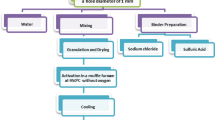Abstract
The characteristics of aerosol flotation, which include the effect of the concentration and particle size of kerosene aerosol on the molybdenum (Mo) flotation index and the effect of kerosene aerosol dosing method on the kerosene dosage and flotation time, were studied in the flotation of low-grade refractory molybdenum ores using kerosene aerosol. The results revealed that the particle size and concentration of kerosene aerosol had little effect on the Mo grade but had significant effect on the Mo recovery. A smaller particle size and a lower concentration of kerosene aerosol were beneficial to the Mo aerosol flotation. For the received Mo ore samples, the optimized particle size of kerosene aerosol was 0.3–2 μm and the optimized aerosol concentration was 14 mg/L. The compressed air atomizer had a more uniform distribution of aerosol particles than the ultrasonic atomizer, and the aerosol concentration was controlled easily, so the compressed air atomizer was more suitable for the research of aerosol flotation. Compared with conventional flotation in which kerosene was directly added into the ore pulp, the flotation time was reduced by ∼30%, and the dosage was decreased by ∼20% in aerosol flotation, while the Mo flotation index was similar.
Similar content being viewed by others
References
G.M. Hidy, Aerosols: An Industrial and Environmental Science, Academic Press Inc., New York, 1984, p.1.
Z.Y. Lu, An Aerosol Science, Atomic Energy Press, Beijing, 2000, p.1.
M.X. Wang and R.J Zhang, Frontier of atmospheric aerosols researches, Clim. Environ. Res., 6(2001), No.1, p.119.
E.Y. Zhu and B. Ma, The present situation of aerosol research in China, Environ. Sci. Manage. 33(2008), No.12, p.57.
Y. Zhu, H.Y. Zheng, X.J. Gu, L.Z. Zhou, X.Y. Guo, W.W. Zhao, L. Fang, and W.J. Zhang, Detection of atmospheric aerosols, Environ. Sci. Technol., 28(2005), Suppl.1, p.175.
R.M. Dickhut, A. Cincinelli, M. Cochran, and H.W. Ducklow, Atmospheric concentrations and air water-flux of organochlorine pesticides along the Western Antarctic Peninsula, Environ. Sci. Technol., 39(2005), No.2, p.465.
S. Villa, C. Negrelli, and V. Maggi, Analysis of a firn core for assessing POP seasonal accumulation on an alpine glacier, Ecotoxicol. Environ. Saf., 63(2006), No.1, p.17.
J. Sun, Retrieval of Aerosol Optical Depth by Hyperspectral Remote Sensing and its Environmental Impact [Dissertation], East China Normal University, Shanghai, 2006, p.8.
Aerosol test group of Liaoning Metallurgy Institute, Aerosol flotation characteristics discussion, Nonferrous Met., 1976, No.3, p.31.
T. Xu, C.B. Sun, Z.Q. Yan, L.P. Mi, S.K. Luo, B. Wang, and L.C. Zhao, Aerosol flotation technology and its application status, China Min. Mag., 20(2011), No.8, p.75.
C.L. Ming, The application of XJX-TA-B16 type flotation machine in coal preparation plant in Tangshan, Coal Process. Compr. Util., 2002, No.3, p.31.
X.H. Zhang and Y.S. Li, The transformation practice of flotation system in Qianjiaying coal preparation plant, Coal Prep. Technol., 2004, No.5, p.35.
H.Z. Yu, The application of XY-3.5 type slurry pretreatment in coal preparation plant, Min. Process. Equip., 33(2005), No.5, p.120.
G.S. Dobby and J.A. Finch, Particle collection in column-gas rate and bubble size effects, Can. Metall. Q., 25(1986), No.1, p.9.
Y. Cebeci, I. Sönmez, A study on the relationship between critical surface tension of wetting and oil agglomeration recovery of calcite, J. Colloid Interface Sci., 273(2004), No.1, p.300.
Z.C. Wang, C.H. Song, and Z.J. Liu, Performance test of Laskin nozzle, Heat. Vent. Air Cond., 40(2010), No.2, p.133.
Author information
Authors and Affiliations
Corresponding author
Rights and permissions
About this article
Cite this article
Xu, T., Sun, Cb. Aerosol flotation of low-grade refractory molybdenum ores. Int J Miner Metall Mater 19, 1077–1082 (2012). https://doi.org/10.1007/s12613-012-0673-4
Received:
Revised:
Accepted:
Published:
Issue Date:
DOI: https://doi.org/10.1007/s12613-012-0673-4




